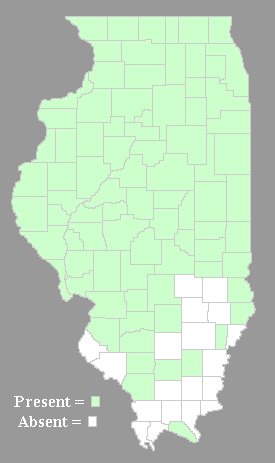Description: This short-lived perennial grass is about 1-2' tall and usually tufted at the base, otherwise it is unbranched. The culms are light green to reddish green, terete, and glabrous. Alternate leaves are produced sparingly along each culm. The leaf blades are up to 4½" long and 5 mm. across; they are light green to pale bluish green, hairless, and erect to ascending. The leaf sheaths are light green to pale reddish green, hairless, and longitudinally veined. The nodes are slightly swollen and reddish to slightly sunken and brown. The ligules are white-membranous.

Each culm
terminates in a nodding spike about 2-4" long. Because of the
spreading awns of its spikelets, this spike is almost as broad as
it is long and obconic in outline. Excluding the awns, the main body of
the spike is cylindrical in shape. During the blooming period, the
spike is light green, often with reddish or
purplish tints, and its appearance is silky and glistening. The
spikelets are densely distributed along the length of each spike. The
spikelets are arranged in clusters of 3, consisting of a single sessile
spikelet that is fertile, and 2 pedicellate spikelets that are
sterile. The sessile spikelet in each cluster has 2 glumes and a
fertile lemma. The glumes of the sessile spikelet are linear in shape
and awned (including their awns, these glumes are 25-75 mm. or 1-3" in
length), while the body of the fertile lemma is 5-7 mm. long, narrowly
lanceolate, convex along its outer surface, and awned (including its
awn, the fertile lemma is 25-75 mm. or 1-3" in length). Each
pedicellate spikelet consists of 2 glumes and 0-1 sterile lemmas. The
glumes of a pedicellate spikelet are linear in shape and awned
(including their awns, these glumes are 25-75 mm. or 1-3" in length),
while the body of the sterile lemma (if it is present) is 0.5 mm. long
and awned (including its awn, the sterile lemma is 25-75 mm. or 1-3" in
length). The floret of each fertile lemma has 3 anthers and a pair
of plumose stigmas. The blooming period occurs during early to
mid-summer (rarely during the autumn). The florets are cross-pollinated
by the wind. Afterwards, the flowering spikes become light tan; the
fertile lemma of each cluster of spikelets contains a single
grain. Individual clusters of spikelets become detached from the rachis
(central stalk) of their spike and fall to the ground while remaining
intact. Because of their persistent awns, these clustered spikelets are
often blown about by the wind, by which means the grains of this grass
are distributed to new areas. The root system is fibrous.
This grass spreads by reseeding itself. It often forms colonies
at favorable locations.
25-75 mm. or 1-3" in
length). The floret of each fertile lemma has 3 anthers and a pair
of plumose stigmas. The blooming period occurs during early to
mid-summer (rarely during the autumn). The florets are cross-pollinated
by the wind. Afterwards, the flowering spikes become light tan; the
fertile lemma of each cluster of spikelets contains a single
grain. Individual clusters of spikelets become detached from the rachis
(central stalk) of their spike and fall to the ground while remaining
intact. Because of their persistent awns, these clustered spikelets are
often blown about by the wind, by which means the grains of this grass
are distributed to new areas. The root system is fibrous.
This grass spreads by reseeding itself. It often forms colonies
at favorable locations.
Cultivation:
The preference is full sun and wet to dry-mesic conditions. Different
kinds of soil are tolerated – from muddy soil to dry gravelly soil.
This grass has a high tolerance of salt and alkaline conditions. It
will not tolerate much competition from taller vegetation.
Range & Habitat:
The native Squirrel-tail Grass is quite common in northern and central
Illinois, while in the southern part of the state it is less common or
absent. Outside of Illinois, this grass is widely distributed in both
North America and Eurasia. Habitats include edges of marshes, muddy
borders along puddles,
poorly drained fields, pastures, vacant lots with compacted soil,
gravelly areas along roads and railroads, mined land, and sterile waste
areas. This grass is typically found in disturbed sunny areas with
scant vegetation.
Faunal Associations:
Insects that have been observed feeding on Squirrel-tail Grass (Hordeum jubatum)
include larvae of the leaf-miner fly Cerodontha superciliosa,
stem-boring larvae of
Cephus cinctus (Western Wheat Sawfly), and such
grasshoppers as Chortophaga
viridifasciata (Northern Green-striped Grasshopper), Orphulella speciosa
(Pasture Grasshopper),
Phoetaliotes nebrascensis (Large-headed Grasshopper), and Pseudopomala brachyptera
(Short-winged Toothpick Grasshopper); see Needham et al. (1928),
Ainslie (1929), and Brust et al. (2008). Other insects that feed on
grasses in this genus (Hordeum
spp.) include Rhopalosiphum
maidis (Corn Leaf Aphid), Sipha flava
(Yellow Sugar Cane Aphid), and other aphids; see Blackman &
Eastop
(2013). Prior to the development of the seedheads, the young foliage of
this grass is palatable to grazing livestock. After the seedheads
develop, the long awns of the spikelets can injure the eyes,
mouth parts, nostrils, and digestive tract of grazing livestock and
other animals. These same animals, especially sheep, can transport the
seeds to new areas after the awned spikelets become lodged in their fur
or wool.

Photographic
Location:
A gravelly area along a railroad in Champaign, Illinois.
Comments:
During early summer, this attractive grass can be found along
interstate highways for mile after mile. It tolerates road salt and
adapts readily to the dry gravelly conditions of the roadside. The
long-awned nodding spikes move gracefully in the wind. Squirrel-tail
Grass (Hordeum jubatum)
would be grown as an ornamental grass, except that it is rather common
and weedy. This grass is easily distinguished from other barley grasses
(Hordeum spp.) by its nodding spikes and their long
awns (greater than 1" in length). Other barley grasses in Illinois,
whether they are native or introduced, have shorter awns and their
flowering spikes are usually more erect. Another common name of Hordeum
jubatum is Foxtail Barley.